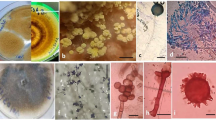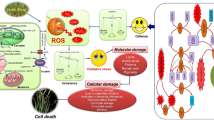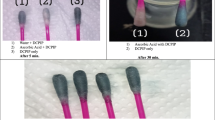Abstract
Cell suspension cultures of potato (Solanum tuberosum, cv. Tamasha) were treated with fusaric acid (FA), a nonspecific fungal toxin produced by Fusarium species to study the effects of FA on H2O2 generation, lipid peroxidation, and activities of antioxidant enzymes, i.e., superoxide dismutase (SOD), catalase, and ascorbate peroxidase (APX). The toxicity of various FA doses was evaluated from viability of cultured cells of S. tuberosum. The toxic concentration of FA (10−3 M) reduced cell viability by 32% after 48-h incubation and induced alkalinization of the medium; the nontoxic concentration of FA (10−6 M) had no effect on cell viability and pH of the culturing medium. The treatment of cells with FA caused rapid reversible accumulation of H2O2 in cells, promoted lipid peroxidation, and elevated the activity of antioxidant enzymes. The toxic FA concentration elevated the intracellular H2O2 content by 51–59% and stimulated lipid peroxidation rate by 35–40%. The nontoxic FA concentration raised the H2O2 content by 84–91% and enhanced lipid peroxidation rate by 18–24%. The addition of FA induced transient biphasic induction of the antioxidant enzymes; the action of toxic and nontoxic concentrations differed in terms of the response amplitudes and dynamics. The results confirm the well-known toxic impact of high doses of FA on the cultured cells, which is determined by membrane transport disorders. In addition, the results reveal that toxic and nontoxic concentrations of FA are able to induce pro- and antioxidant systems in the cultured cells of S. tuberosum.
Similar content being viewed by others
Abbreviations
- APX:
-
ascorbate peroxidase
- FA:
-
fusaric acid
- MDA:
-
malondialdehyde
- ROS:
-
reactive oxygen species
- SOD:
-
superoxide dismutase
References
Knoche, H.W. and Duvick, J.P., The Role of Fungal Toxin in Plant Disease, Fungal Infection in Plant, Pegg, G.F. and Ayres, P.G., Eds, Cambridge: Cambridge Univ. Press, 1987, pp. 158–191.
Wang, H., Li, J., Bostock, R.M., and Gilchrist, D.G., Apoptosis: A Functional Paradigm for Plant Cell Death Induced by Host-Selective Phytotoxin and Invoked during Development, Plant Cell, 1996, vol. 8, pp. 375–391.
Bacon, C.W., Porter, J.R., Norred, W.P., and Leslie, J.F., Production of Fusaric Acid by Fusarium Species, Appl. Environ. Microbiol., 1996, vol. 62, pp. 4039–4043.
Bilai, V.I., Fuzarii (Fusarium sp.), Kiev: Naukova Dumka, 1977.
Kohler, K. and Bentrup, F.W., The Effect of Fusaric Acid upon Electrical Membrane Properties and ATP Level in Photoautotrophic Cell Suspension of Chenopodium rubrum L., Z. Pflanzenphysiol., 1983, vol. 109, pp. 355–361.
Marre, M.T., Vergani, P., and Albergoni, F.G., Relationship between Fusaric Acid Uptake and Its Binding to Cell Structures in Leaves of Egeria denca and Its Toxic Effects on Membrane Permeability and Respiration, Physiol. Mol. Plant Pathol., 1993, vol. 42, pp. 141–157.
Kuzniak, E., Patykowski, J., and Urbanek, H., Involvement of the Antioxidative System in Tomato Response to Fusaric Acid Treatment, J. Phytopathol., 1999, vol. 147, pp. 385–390.
Kuzniak, E., Effect of Fusaric Acid on Reactive Oxygen Species and Antioxidants in Tomato Cell Culture, J. Phytopathol., 2001, vol. 149, pp. 575–582.
Bouizgarne, B., El-Maarouf-Boutenau, H., Frankart, C., Reboutier, R., Madiona, K., Pennarun, A.M., Monestiez, M., Trouverie, J., Amiar, Z., Brian, J., Brault, M., Rona, J.P., Ouhdouch, Y., Hadrami, I.E., and Bouteau, F.A. Early Physiological Responses of Arabidopsis thaliana Cell to Fusaric Acid: Toxic and Signaling Effects, New Phytol., 2006, vol. 169, pp. 209–218.
Droge, W., Free Radicals in the Physiological Control of Cell Function, Physiol. Rev., 2002, vol. 82, pp. 47–95.
Hung, Sh., Yu, Sh., and Lin, Sh., Hydrogen Peroxide Functions as Stress Signal in Plants, Bot. Bull. Acad. Sinica, 2005, vol. 46, pp. 1–10.
Blokhina, O., Virolainen, E., and Fagerstedt, K.V., Antioxidants. Oxidative Damage and Oxygen Deprivation Stress: A Review, Ann. Bot., 2003, vol. 91, pp. 179–194.
Desmond, O.J., Manners, J.M., Stephens, A.E., Maclean, D.J., Schenk, P.M., Gardiner, D.M., Munn, A.L., and Kazan, K., The Fusarium Mycotoxin Deoxynivalenol Elicits Hydrogen Peroxide Production, Programmed Cell Death and Defence Responses in Wheat, Mol. Plant Pathol., 2008, vol. 9, pp. 435–445.
Aver’yanov, A.A., Lapikova, V.P., and Lebrun, M.-H., Tenuazonic Acid, Toxin of Rice Blast Fungus, Induces Disease Resistance and Reactive Oxygen Production in Plants, Russ. J. Plant Physiol., 2007, vol. 54, pp. 841–846.
Gay, C., Collins, J., and Gebicki, J.M., Hydroperoxide Assay with the Ferric-Xylenol Orange Complex, Anal. Biochem., 1999, vol. 273, pp. 149–155.
Zhirov, V.K., Merzlyak, M.N., and Kuznetsov, L.V., Lipid Peroxidation in Membranes of Cold-Resistant Plants after Damage with Below-Zero Temperature, Sov. Plant Physiol., 1982, vol. 29, pp. 1045–1052.
Aebi, H., Catalase In Vitro, Methods Enzymol., 1984, vol. 105, pp. 121–126.
Nakano, Y. and Asada, K., Hydrogen Peroxide Is Scavenged by Ascorbate-Specific Peroxidase in Spinach Chloroplasts, Plant Cell Physiol., 1981, vol. 22, pp. 867–880.
Beauchamp, C. and Fridovich, J., Superoxide Dismutase: Improved Assays and an Assay Applicable to Acrylamide Gels, Anal. Biochem., 1971, vol. 44, pp. 276–287.
Bradford, M.M., A Rapid and Sensitive Method for the Quantitation of Microgram Quantities of Protein Utilizing the Principle of Protein-Dye Binding, Anal. Biochem., 1976, vol. 72, pp. 248–254.
Zaitsev, G.N., Matematika v eksperimental’noi botanike (Mathematics in Experimental Botany), Moscow: Nauka, 1990.
Telles-Pupulin, A.R., Salgueriro-Pagadigorria, C.L., Bracht, A., and Ishii-Iwamoto, E.L., Effects of Fusaric Acid on Rat Liver Mitochondria, Comp. Biochem. Physiol. C. Toxicol. Pharmacol., 1998, vol. 120, pp. 43–51.
Bouizgarne, B., Brault, M., Pennarun, A.M., Rona, J.P., Ouhdouch, Y., El Hadrami, I., and Bouteau, F.A., Electrophysiological Response of Root Hairs from Seedlings of Date Palm Susceptible and Resistant to Fusarium oxysporum f. sp. albedinis, J. Phytopathol., 2004, vol. 152, pp. 321–324.
Gapillout, I., Milat, M.L., and Blein, J.P., Effect of Fusaric Acid on Cells from Tomato Cultivars Resistant or Susceptible to Fusarium oxysporum f. sp. lycopersici, Eur. J. Plant Pathol., 1996, vol. 102, pp. 127–132.
Merzlyak, M.N., Aktivirovannyi kislorod i okislitel’nye protsessy v membranakh rastitel’noi kletki (Activated Oxygen and Oxidative Processes in Plant Cell Membranes), Itogi Nauki i Tekhniki, Ser. Fiziol. Rast., 1989, vol. 6.
Author information
Authors and Affiliations
Corresponding author
Additional information
Original Russian Text © O.A. Sapko, A.Sh. Utarbaeva, S. Makulbek, 2011, published in Fiziologiya Rastenii, 2011, Vol. 58, No. 5, pp. 711–718.
Rights and permissions
About this article
Cite this article
Sapko, O.A., Utarbaeva, A.S. & Makulbek, S. Effect of fusaric acid on prooxidant and antioxidant properties of the potato cell suspension culture. Russ J Plant Physiol 58, 828–835 (2011). https://doi.org/10.1134/S1021443711050190
Received:
Published:
Issue Date:
DOI: https://doi.org/10.1134/S1021443711050190




